ASUS G74SX: Noteworthy Updates to ASUS' G7 Series
by Jarred Walton on October 6, 2011 12:00 AM ESTApplication Performance: Add an SSD for Improved Performance
The last-gen G73SW would offer nearly identical performance in our application suite were it not for one thing: the Intel 320 Series SSD in the G74SX. Keep the same processor, improve GPU performance a bit, and add in an SSD and what you get is markedly faster boot and application start times and a smoother overall experience. We’ve mentioned how much Futuremark’s PCMark suites skew towards SSDs, but there’s something to be said for what an SSD can provide. I still feel like it should be more like a 30% improvement in application scores—and you really mostly notice it when launching applications or booting, particularly if you launch multiple applications at once or have half a dozen startup programs. We’ll start with the PCMark suites before moving into CPU-limited testing.
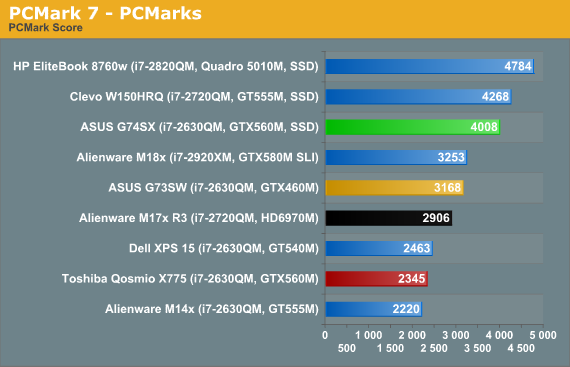
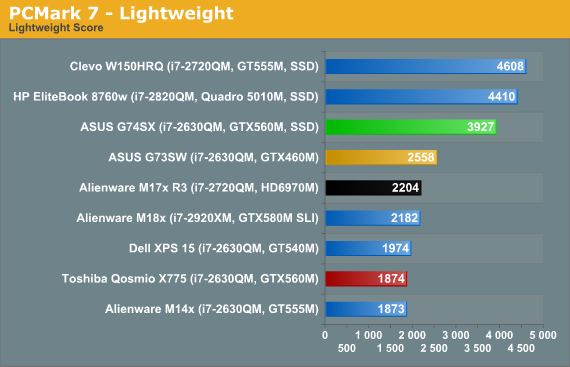
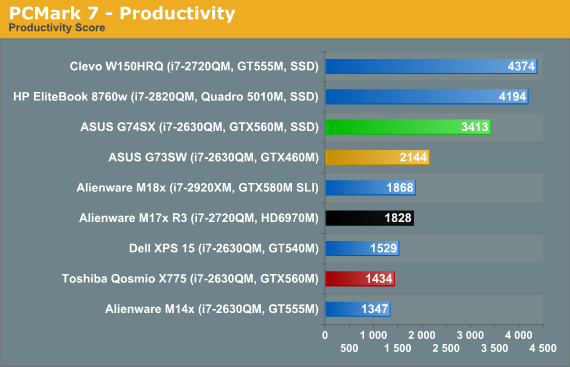
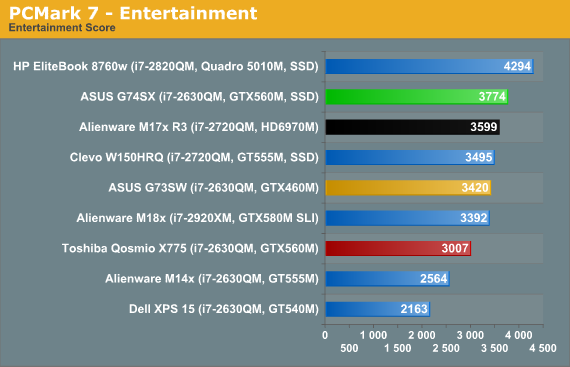
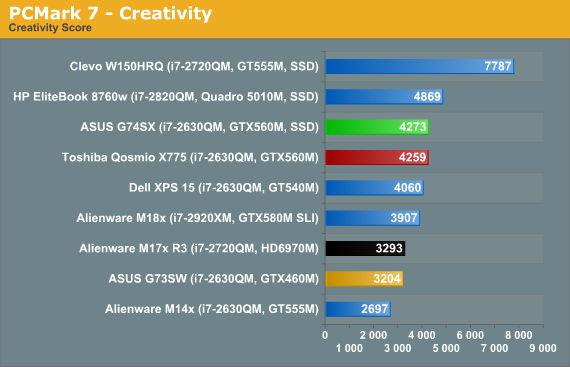

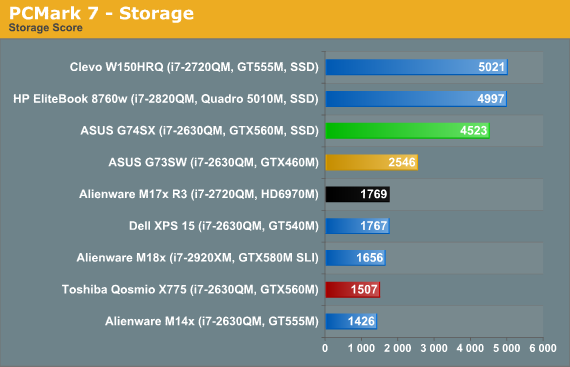

So I just said that I felt the overall benefit to general performance from an SSD should be around 30%, and for the overall PCMark 7 suite that’s exactly what we get: the G74SX ends up 27% faster than the G73SW. Elsewhere, the G74SX is anywhere from equal to its predecessor (the Computation score), to 10% faster (Entertainment), to around 30% faster (Creativity), or as much as 50 to 80% faster (Lightweight, Productivity, and Storage). Turning to the older PCMark Vantage, the G74SX tops the G73SW by 42%.
Moving to a slightly different notebook, however, we can see the problem: the G74SX is 38% faster than the Alienware M17x R3 in the overall PCMark 7 suite, even though the Alienware has a faster i7-2720QM processor, and it’s 155% faster in the storage benchmark—and the M17x is sporting RAID 0 750GB HDDs. ASUS has somehow optimized storage performance so that PCMark 7 really favors their notebooks, and the SSD boosts their score by an appropriate ~30%, but the G73SW already outperforms similarly equipped laptops (e.g. the Dell XPS 15) by 28%, likely thanks to storage optimizations.
I can’t really say that any of the individual scores are without merit, but I can say that you shouldn’t expect a 50% boost in gaming performance from adding an SSD—even if you happen to have enough free space on our SSD to hold the games you play. Similarly, video encoding performance and other computationally intensive tasks are still going to hinge on raw CPU speed, and PCMark’s Computation result reflects this (assuming you’re not using Quick Sync, which we’re not on most of these notebooks, the Qosmio, XPS 15, and W150HRQ being the exceptions). Here are the results from the remainder of our application suite, along with a few 3DMark scores, to round out our general performance overview.
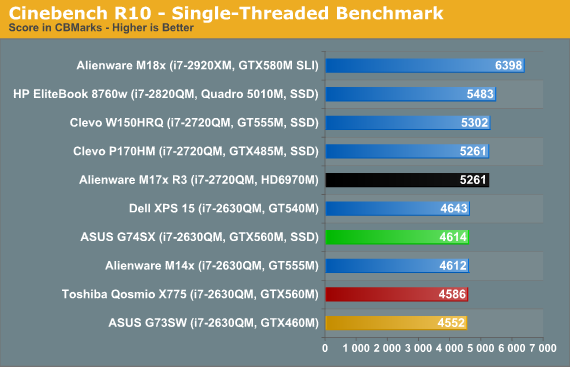
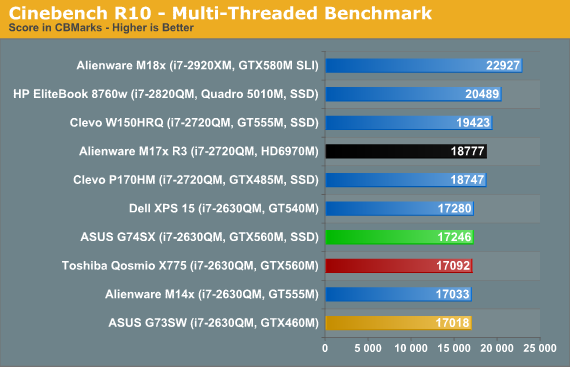
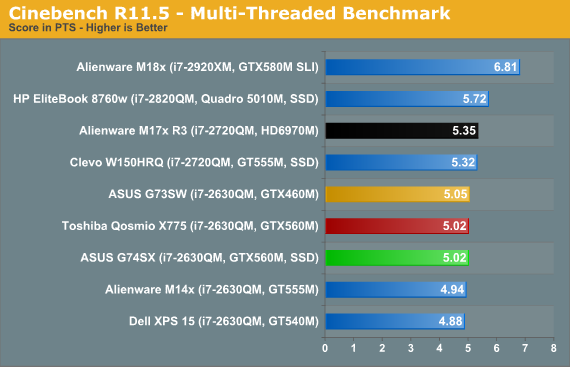
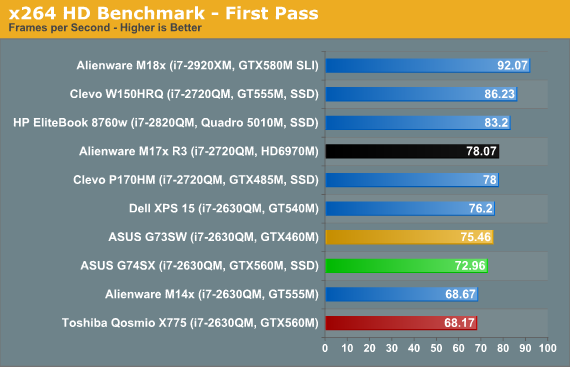
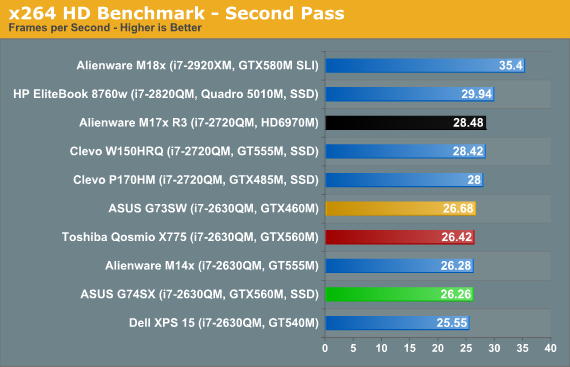

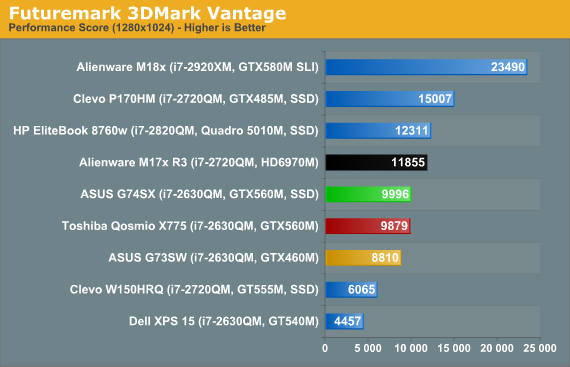
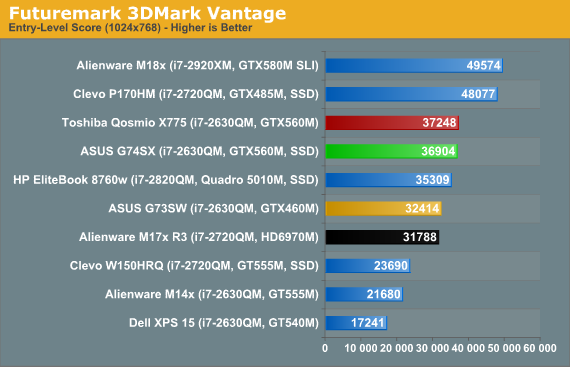
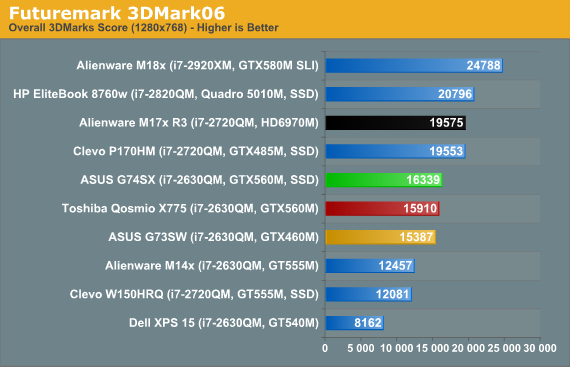
The i7-2630QM is a well-known quantity, and the results fall out right about where we’d expect. There’s some minor variation in performance in the x264 encode first pass, but nothing to worry about. 3DMark gives us our first glimpse of the graphics upgrade the GTX 560M brings to bear, and the results range from 22% faster than the G73SW (3DMark 11) to only 6% faster (3DMark06). We’re also testing with a newer driver release on the G74SX, which may explain the score discrepancy between the ASUS and the Toshiba Qosmio. Optimus may also be a factor, but more likely it’s just drivers. Let’s hit the gaming results next for a full look at graphics performance.










44 Comments
View All Comments
seapeople - Friday, October 7, 2011 - link
Don't say things like that, because soon we'll be hearing from the "I have 32GB of RAM and it's not enough for my super duper special application load" crowd.JojoKracko - Tuesday, October 11, 2011 - link
He is saying 8GB because the 16GB is useless for the rest of the computer's specs. It is just a waste. Cheap marketing poop.DanNeely - Thursday, October 6, 2011 - link
The table at the start of the review indicates a HannStar panel, the LCD page says it's a Chimei Innolux.Joehettinger - Thursday, October 6, 2011 - link
I have a G73, and slapped a WD 128 GB SSD in it, the only problem I had was the lack of brackets and the weak chip-set limited me to 150 Mb transfers from the drive. It's good to see that they upgraded the chip-set so that the SSD can run at full speed.Also, the little rubber foot pads came off the first week or two. Anyone else have that problem? Did ASUS come up with a better way to mount the foot pads.
I'm also voting for the 16:10, I would love to have more vertical space.
And finally, A USB 3.0 port ... Outstanding!
andrewcooke - Thursday, October 6, 2011 - link
is there any site that provides a simple overview of the different asus models and their specs? the asus site is a real mess and doesn't explain anything unless you look in detail at each model. thanks.Wolfpup - Friday, October 7, 2011 - link
Not that I know of, but there's not that much variation. Basically the biggest change is the Best Buy model "only" has a 128-bit memory interface for the video RAM rather than the 192-bit interface on the other models (but it's also cheapest).Besides that you've got some variation in whether there's 1 or 2 drives (and thus a second drive bracket and cable), Blu Ray, and apperently this A2 model "only" has 1.5GB video RAM instead of 3GB like on most. (The ones with 2GB you know have a 128-bit memory interface because 192-bit ends up needing either 1.5 or 3GB to do that.)
Obviously Blu Ray is a must have, and I wanted the kit for the second hard drive, so the A1 model worked well for me, though frankly even the Best Buy model's a good deal, relative to a lot of other systems.
andrewcooke - Sunday, October 9, 2011 - link
hey, thanks for the reply, but i didn't mean just for this model, but for all asus laptops. i live outside the usa so need to select from info on the net (and then quickly buy something when i travel there). cheers.JojoKracko - Tuesday, October 11, 2011 - link
Search for G74 pdfI came across a pdf once that listed all of the specs for the many, many world wide variations of G74s. I think it was some Montreal computer shop, but it was in English.
Death666Angel - Thursday, October 6, 2011 - link
If I were in the market for such a notebook (read: desktop replacement with gaming capabilities), this would probably be it. Nicely balanced components, good looks, priced adequately.Paedric - Thursday, October 6, 2011 - link
I'm the owner of an original g73jh with an amd 5870, and there are several long term issue with.First, amd drivers cause screens of death, asus recommend the stock drivers.
That'd be fine if the latest version wasn't nearly 2 years old.
A common issue is the thermal paste of the gpu.
After some time, it needs to be changed, otherwise the gpu idles at about 80C and get as hot as 110C, before the system shuts down.
I don't know if the g series is still having those issues since it's not the same gpu anymore, but it has kinda ruined an awsome laptop for me.